

GROWER OF THE YEAR 2025



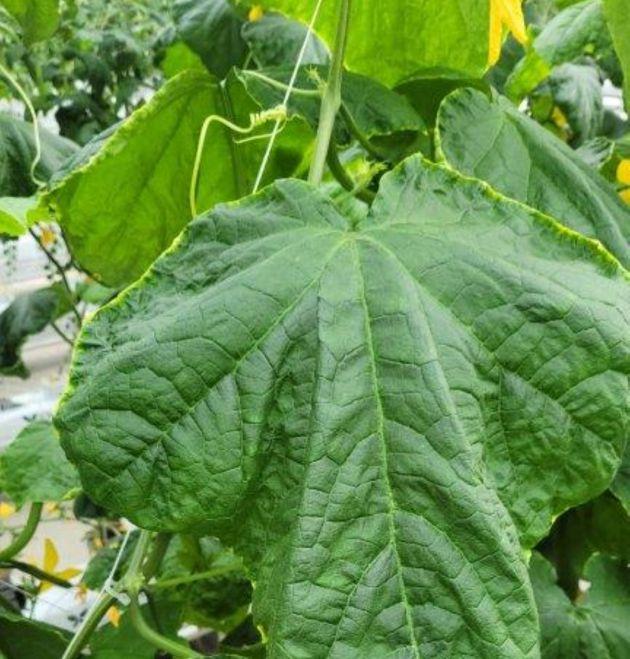
Consumer trends
A growing number of customers want to know the stories behind the products they purchase and where they came from. Read more on 14.
4
8

Garden centres How politics has been playing out in the retail space over the summer.
BY ANNE KADWELL AND STUART SERVICE
Lighten up Pointers for adapting production to seasonal light changes.
BY DR. MOHYUDDIN MIRZA
Cultivating profit Annual business review could generate opportunities for growth.
BY MELHEM SAWAYA
Jolly Farmer’s head propagator and 2025’s Grower of the Year, Roberto Corea.
Photo courtesy Jolly Farmer Inc.

Turning a negative into a positive
Several weeks ago, I had the pleasure of sitting down with Jolly Farmer’s head propagator and our 2025 Grower of the Year, Roberto Corea.
In these interviews I always like to ask: ‘What motivates you?’ I found Roberto’s response to be quite surprising. He explained that a discouraging interaction with someone he viewed as a mentor very early in his career continues to light a fire under him. The mentor tried to quell Roberto’s curiosity by telling him ‘there’s nothing left to learn’ in the world of horticulture and that trialling and research is a waste of time and energy and to just work with what you know.
with retailers to see what’s been going on in that space and it may come as no surprise that U.S. trade politics are influencing purchasing. Read more on Page 14.
For those planning for the 2026/7 season, check out Part 2 of our coverage of the 2025 California Spring Trials. This batch of breeding breakthroughs and variety innovations are not only breathtaking, but compatible with production in Canada. Read more on Page 18. And while you’re thinking about production for the 2026 season, Mel Sawaya has a few suggestions for your consideration to streamline operations and perhaps shave a little off your bottom lines on Page 28.
As the days are starting to get a little shorter, our own Dr. Mohyuddin Mirza is encouraging growers to think about how they will adapt their strategies to the changing light conditions. He offers his insight on managing greenhouse cucumber crops and what can be done to mitigate challenges associated with the changing seasons on Page 24
‘[Roberto] has become the embodiment of innovation and progress’.
Obviously, the likely discontented mentor was so very wrong and young Roberto set out to prove it. In fact, in the years since, he has become the embodiment of innovation and progress in the commercial greenhouse sector by embracing the very things his so-called mentor frowned upon. He actively seeks out opportunities to learn and experiment and views the process of passing on that knowledge to the next generation of growers as sacred. Roberto’s ability to turn such a negative and disappointing experience into an engine to drive progress and positivity is inspirational. Read more about Roberto and his impact on Jolly Farmer and the sector on Page 8. In this issue, we also take a look at what was happening in garden centres across Canada this summer. Our friends with the Canadian Nursery Landscape Association (CNLA) took some time to touch base
Putting the exclamation point on this issue is Inside View columnist, Gary Jones. He is very on trend this month as he discusses the importance of tracking what’s popular among consumers and making an effort to understand their purchasing motivations. This, he maintains, is an important piece in planning for the future. Read his take on Page 34.
Enjoy this end-of-summer issue and, as ever, reach out to me at akouniakis@annexbusinessmedia.com with any comments or suggestions.



FCC revamps loan terms to streamline farm, agri-food business transfers
Farm Credit Canada (FCC) has announced adjustments to the terms of its Transition Loan to improve the process of transferring agriculture and agri-food business assets between sellers and buyers.
In a recent news release, the financial services provider said the new terms come at a time when Canada’s agriculture and food system is sitting on more than $50 billion in farm assets which are expected to be transferred in the next 10 years.
The updated loan terms will allow disbursements to the seller over a period that extends to 10 years, the release said. It adds that the loan is available
for farms, agribusinesses or food businesses going through changes in ownership, within or outside of the family.
According to the release, the seller is guaranteed full payment of the sale proceeds by FCC, a customized payment schedule for up to 10 years and the opportunity to support a next generation entrepreneur.
For the buyer, the release said,e the new terms do not require upfront capital for a down payment, provide flexibility to choose between improving cash flow or building equity and include the company’s AgExpert software. (Source: Farm Credit Canada)
MODULAR FARMS TO GROW GREENS FOR OTTAWA SHELTER’S EXPANSIVE FOOD PROGRAMS

The Ottawa Mission, in collaboration with RBC and Ottawa-based Growcer, has announced a new initiative to enhance food security for vulnerable community members and create valuable training opportunities in the nation’s capital.
In a recent press release, Ottawa’s oldest and largest homeless shelter said the project,
made possible by a $1.5-million donation from RBC through the Ottawa Community Foundation for the Food Resiliency Foundation Fund, will establish two modular vertical farms that will enable the shelter to grow fresh greens for its meal programs.
“Over each of the past three years we’ve served over one million meals per year to people in
OGVG wins two advertising awards
Ontario Greenhouse Vegetable Growers (OGVG) is celebrating double wins after being awarded with two Gold Digital Advertising Awards for its ‘Fall Freshness’ and ‘Grocery Giveaway’ marketing campaigns promoting greenhouse-grown produce.
‘The Fall Freshness’ and ‘The Grocery Giveaway’ campaigns being rolled out across the Atlantic U.S. Developed in collaboration with Douglas Marketing Group (DMG), the initiatives were extensions of the OGVG’s ongoing Greenhouse Goodness marketing campaign and celebrating the benefits of greenhousegrown produce being available year-round.(Source: Ontario Greenhouse Vegetable Growers)
need,” said Peter Tilley, Ottawa mission CEO, in the release.
“A greater number of people than ever before can’t afford to eat healthy food, which leaves them at higher risk of diet-related illness. We’re delighted that this initiative ensures access to nutritious local produce year-round which will help keep our clients healthy.”
The modular farms,
supplied by local vertical farming company, Growcer, are expected to produce 20,000 pounds of greens annually to support the shelter’s various meal programs, which include serving shelter clients, community members, and a rapidly growing food truck program, that currently dishes up to 10,000 meals a week. (Source: Ottawa Mission)
BY THE NUMBERS
Source: Energy statistics, April 2025; Statistics Canada
Total electricity generation in Canada increased 7% (y/y) to 48.9 million megawatt-hours (MWh) in April 2025
Exports of electricity to the United States jumped 54.8% year over year while imports fell 34.6%.

Reach New Heights with Skyscraper RZ
Meet Skyscraper RZ , the high-performing long English cucumber variety from Rijk Zwaan. It produces medium-length fruits with impressive yields and is designed to be labour friendly, thanks to its strong vigour and open plant habit. Skyscraper RZ comes equipped with a double resistance disease package, ensuring your crop stays healthy and productive throughout the season. Contact us to learn how you can reach new heights with Skyscraper RZ and elevate your cucumber assortment!

For more information, contact: Rijk Zwaan Canada | John Devries, Cucumber Crop Specialist | j.devries@rijkzwaan.com RZH Canada Ltd. | Max Saad, Director of Sales | max@rzhcanada.ca www.rijkzwaanusa.com

Propagating progress
Jolly Farmer’s Roberto Corea is 2025’s Grower of the Year
BY AMY KOUNIAKIS
In selecting Greenhouse Canada’s Grower of the Year, we look to highlight the career of those individuals who exemplify the spirit of innovation and curiosity, who lead with passion and dedication to the craft of greenhouse growing, and who propel the industry forward.
Among the numerous nominations we received in 2025, there was one individual whose inspirational story and demonstrated impact on the sector captivated us: Roberto Corea, head propagator at Jolly Farmer Products Inc.
NICARAGUA TO NEW BRUNSWICK
Corea’s journey from his birthplace in Chinandega, Nicaragua to Northampton, New Brunswick, where Jolly Farmer is headquartered, is one fuelled by curiosity, a love for plants and horticulture, and, at times, motivated by disappointment.
As the son of a lawyer and retired military member, Corea’s exposure to greenhouse growing and horticulture came a little later in life.
“My passion for plants was sparked, I think, during high school,” Corea told Greenhouse
ABOVE Roberto Corea, head propagator at Northampton, N.B.’s Jolly Farmer Ltd. pictured October 2024 while visiting one of the company’s stock farms, Vivero International, in Mexico.
Canada in a recent interview. “I loved science and biology and that led me to the decision to study agronomy.”
After high school, he studied at Universidad de Catolica del Tropico seco (Catholic University of the Dry Tropics) in Esteli, Nicaragua and it was during this time that he entered his first commercial greenhouse.
“During the first year, we went to a greenhouse where they grew vegetables,” he recalls. “When I walked in there, I was like: ‘Wow!’ And from that moment on, I said I want to work in greenhouses.”
Upon graduation, Corea started working at one of Ball’s offshore stock farms, Las Limas, in Esteli, where he was responsible for elite stock, propagation, new varieties trials and flower check.
While working for Ball, he became familiar with name Jolly Farmer and, given the quality of their products and their prevalence in the industry, Corea said he was curious about the possibilities that might be available to him with the Canadian company. He reached out to the company, and others, in pursuit of opportunities but there were none at the time.
He continued his work with coffee plants, propagating them from both tissue culture and seeds. Corea said in these roles

ABOVE
Roberto Corea at Grower Day 2025 accepting the Grower of the Year Award.
he gained an appreciation for trialling new varieties and experimenting with different methods of propagation and cultivation.
GROWTH-LIMITING GUIDANCE
During this time, he recalls, he worked under a very senior grower who he viewed as his mentor. Corea says a discouraging interaction with her has remained with him to this very day and it continues to motivate his approach to the industry.
“I was just starting in the industry, and she really had a lot of experience,” he said, noting that he was fascinated with trialling as a means to expand his knowledge. “She really didn’t like it. She told me ‘there’s nothing new to find out or learn so why keep doing it?’”
It was an eye-opening moment, Corea says, because instead of dampening his spirits, it lit a fire under him.
“It was disappointing, but I knew there’s nothing written in stone; there’s always something new to learn and I


LEFT
Jolly Farmer’s head propagator Roberto Corea shows off some of the company’s prestine spring crops.
want to keep improving. It motivated me.”
In the pursuit of improvement, he applied to further his experience in the U.S. and entered the yearlong CEAP training program in Connecticut. While in the U.S., more than a year after reaching out to them, an HR representative from Jolly Farmer reached out to encourage Corea to apply again and in 2018, he was hired.
BIG MOVES
A short time later, Corea, his wife and daughter made the move to picturesque Northampton, New Brunswick. Since moving here, Corea has become a Canadian citizen and welcomed, a little under two years ago, a son.
“I’m very proud of where I am right now,” he said. “It’s been a long journey.”
In the nearly eight years that Corea has been with the company, he has committed himself to finding ways to improve efficiencies in the production process.
“[Roberto] doesn’t just accept the status quo — he actively challenges it, always asking how processes can be improved and how outcomes can be optimized,” said Gregory Weir, a senior line grower with Jolly Farmer and Corea’s friend and Grower of the Year nominator.
PRECISE PROPAGATION
A key to successful propagation, according to Corea, is ensuring “good quality cuttings,” which he describes as being a good size, have a healthy appearance, free of bugs/disease, not stretchy, mature, and toned.
“If we don’t get good quality cutings from the beginning then we’re going to be struggling the whole season,” he said. “If we have a thin or a soft cutting, it’s going to take longer to root and it’s going to need more PGR.”
To ensure pest and disease pressures don’t eat into production


RESILIENCE HARVESTING
OCTOBER 8 & 9, 2025 • NIAGARA FALLS, ON CANADA






ABOVE
“I think supporting the young growers is not just an important role; it’s one of the most rewarding things that I can do. It’s not about just cultivating plants; It’s about cultivating people too.”
time and profits, Jolly Farmer has a large crew dedicated to inspecting incoming plant material.
“We play a lot with the proactive IPM or integrated pest management and we dip a lot of cutings because if we find something then we dip them and we’ll try to keep the the greenhouse clean.”
In one of his biggest challenges as a grower, it was Corea’s keen eye and deep industry knowledge that enabled him to correct a crop of poinsettia that was well off projected growth targets mere weeks before shipping to a massive retailer.
“We had to make environmental changes very quickly to gain the inches that we needed,” he said, noting that with a temperature adjustment, supplemental lighting, employing a more ‘aggressive’ fertilizer and adjusting irrigation volumes, they were able to ship healthy, beautiful plants on time.
“It was day-to-day but, in the end, they were really nice,” he recalls proudly.
For Corea, though, this victory was bittersweet as he says poinsettia still present a host of unique challenges every year.
“It’s the crop that keeps me humble,” he jokes, adding that from the moment they stick their poinsettia crop until they ship, “it’s five months of stress.”
Stressful though it may be, in his time with Jolly Farmer, through trialing and engagement with consultants and industry experts, Corea has been able to optimize rooting of the crop to the point where he has shaved time and money off the process by dipping cuttings with IBA (Indole-3-butyric acid) and NAA (Naphthaleneacetic acid), replacing the previous method of spraying trays before sticking.
“My approach has been to bring
Corea pictured at Cultivate in Columbus, OH. Roberto is an avid, life-long student of horticulture, always seeking out ways to expand his knowledge and pass it on to younger growers.
more scientific, data-driven methodologies to our daily operations,” he said.
Through trialling, Corea determined that a more efficient and affordable method of fertigation through mist for crops like Petunia, Calibrachoa and Lobelia can result in weeks being shaved off production.
Corea’s careful attention to detail on a routine walk of Jolly Farmer’s greenhouses also led to the industry-wide revelation that Calibrachoa is susceptible to Chili Pepper Mild Mottle Virus (CPMoV).
“I just saw some some weird spots on the plant and then I started looking at it and then I saw it was just that variety,” he said. “I called the specialist here and I told her probably we should test it for virus.”
Tests revealed the presence of this devastating pestilence on location and at the company’s stock farms, necessitating the crop’s destruction but marking a key discovery for the sector. While the company suffered a great financial hit in the ordeal, Corea took some pride in knowing that it would lead to improved virus detection and production methods across the sector.
MOTIVATIONAL MENTOR
His motivation to see the industry progress and improve also plays out in his dedication to sharing his hard-earned knowledge with a younger generation of growers.
“Roberto plays a vital role in training new [Jolly Farmer] staff, passing on his knowledge and passion for horticulture to ensure that the industry continues to thrive,” Weir wrote in his nomination. “His mentorship builds both confidence and competence in young growers, fostering a culture of excellence and long-term commitment.”
He describes his leadership style as “coaching-oriented and collaborative” and encourages participation and outside-thebox thinking by asking: ‘What do you see?’
“It gets them talking,” he said, which leads to more questions and possibilities.
As a leader and grower, Corea says the knowledge-sharing aspect of his work is where he finds the most fulfilment.
“I think supporting the young growers is not just an important role; it’s one of the most rewarding things that I can do,” he said. “It’s not about just cultivating plants; It’s about cultivating people too.”
The key piece of advice he likes to share with young growers?
“Always be a detective,” he said with little pause. “And never stop trialling or experimenting.”
Now we can grow!
With high resistance against ToBRFV



We’ve developed high resistance tomato varieties against ToBRFV –strong and uncompromising in quality. Together with the right sanitary measures, we’re creating a brighter future for all. We’ve made it now we can grow!





















Political purchasing
Canadian independent garden centres see growing interest in locally sourced plants and products
BY ANNE KADWELL AND STUART SERVICE, CANADIAN NURSERY LANDSCAPE ASSOCIATION
Across the country, independent garden centres are seeing a shift that reflects the political dynamics of North America. While many have always leaned into locally grown plants and Canadian-made goods, a growing number of customers are wanting to know the stories behind the products and where they came from.
The response has been both practical and principled, with operators adjusting buying habits, updating signage, and reconsidering what “local” really means.
“We’ve always sourced locally,” said Tanya Olsen
ABOVE

of Royal City Nursery in Guelph, ON. “But now we’re getting asked about it.”
At her garden centre, most plants are grown within a one- to two-hour radius. For Olsen, the benefits are clear, as nearby suppliers provide plants that are stronger due to shorter travel distances, and are better adapted to the local climate.
“We have an incredible opportunity to be a lot louder about the fact that our plants are grown locally in Canada and for us in Guelph,” she said. “The wild part is: that’s always been the case.”
Tropicals and houseplants remain a challenge
Jordan Hiebert of Lacoste Garden Centre in Winnipeg, MB (pictured above) said that garden centres are unique in their ability to grow and sell plants on site just steps from where customers shop.




for Saunders is a noticeable demand for Canadian flags.
“We could have sold hundreds,” she said. “It seemed like every second person coming in in the spring, when they were looking to replace their decorative flags, wanted a Canadian flag.”
Cedarcrest supports local food, crafts and giftware by hosting a farmers’ market in their greenhouse during the winter months.
due to being mostly imported from the southern U.S. But recent customer aversions to purchasing American plant material has led Tanya to explore local options.
“There’s some fantastic Canadian growers that we may not have dealt with before, that have always been there, and that can fill some of those gaps,” she said.
Heather Saunders, Senior Product Adviser at Cedarcrest Gardens in St. John, NB, said her team took steps early in the season to spotlight their Canadiangrown offerings. Most annuals and perennials are grown at their own farm, while trees and shrubs come mainly from Ontario and Quebec.
The biggest difference this season
“A lot of people like supporting the farmers market,” Saunders said. “And it gives the vendors something to do in the wintertime when they wouldn’t normally have anywhere to sell their goods.”
In Winnipeg, MB, Jordan Hiebert of Lacoste Garden Centre noted that many garden retailers have the rare ability to manufacture what they sell right on site.
“We manufacture the product we sell on location,” he said in an interview at his office.
THIS PAGE
Bradford Greenhouses Garden Gallery in Barrie, ON highlights home-grown plant material on the tags of products throughout their 87,000 square-foot store.
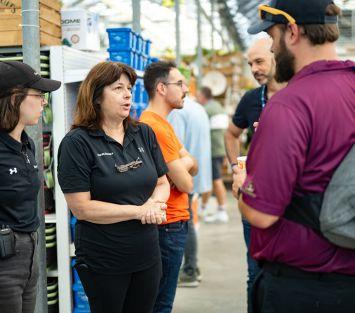

THIS PAGE
Independent garden centres have always leaned into locally grown plants and Canadian-made goods, though a growing number of customers are wanting to know the stories behind the products and where they’re coming from.
“We grow our plants literally 100 feet beyond that wall right there,” Hiebert continued. “We can’t do that with clothing. It’s not like they’re sewing the clothes in the back and then bringing it up to the front for retail.”
Early in the season, Hiebert noticed a wave of questions about where plants were coming from. His team responded with a campaign slogan: “locally grown, locally loved.” They’ve pivoted this year by ordering more hard goods from Canada, and visiting international suppliers in the Netherlands to further avoid relying on American sources.
“That sentiment was strong in the late winter, but relatively nonexistent in spring,” he said. “I don’t think I got asked the question a single time in May. Maybe we answered a lot of those questions so they didn’t get asked.”
In Stirling, ON, Karina Lapierre McIntosh of Lavish Gardens is also focused on local sourcing with an emphasis on how plants are propagated.
“I like to buy from local growers that grow from open pollinated seeds produced in our local environment,” she said. “I’m not a botanist, but I figured that the more diversity in the plant world is best because with climate change and the world that we live in, we want plants that have genetic diversity.”


The supply chain has its limits, as sourcing hard goods remains a challenge. “I did cancel some orders of hard goods that were from American suppliers. It was a little bit sad, but sometimes you just have to kind of do your part.”





Trendy, grower friendly and ready for retail
Varieties featured in Part 2 of our coverage of CAST 2025 zero in on key themes
BY RODGER TSCHANZ
As we look at the final two days of the journey through the 2025 California Spring Trials, consider how many of this year’s highlighted varieties have been developed to reduce inputs, improve garden performance and survive north of the 49th parallel.
Enjoy Part 2 of our coverage of CAST 2025!
DAY 3
BENARY
This will have been the last CAST for Benary at this Watsonville location. Benary has sold the property and will be consolidating the breeding formerly done here at its facilities in Germany.
Benary is known for its begonia breeding and has released the new Mega Cool (1) series to fill the gap in vigour between the Super Cool series and the BIG series. For comparison purposes, this series would be similar in vigour to Syngenta’s TopHat offerings. Mega Cool cultivars have the flower size of the BIG series arising from a smaller plant. This plant can be used for patio pots, containers and in the landscape. It is currently only available with green foliage and in flower colours of scarlet, white, rose, pink and in a four-colour mix.
For the cut flower market, Benary has released the Craspedia, Solar Pop (2), as a seed alternative
to the vegetative options that are currently available. Craspedia is trendy as a cut flower and this selection, with its large golden heads, is attractive to beneficial insects in the garden and can be used in both containers and the landscape.
Pentas is a heat-loving plant and traditionally has been available as an upright potted plant. This year, Benary, in a breeding break through, is releasing a true trailing pentas from seed. The series name is Graffiti Falls (3) and is currently only available in a rose colour. The cascading habit of this plant is well suited for containers and hanging baskets, but it is not recommended for landscape use. It can reach a height of 18 cm and spread as much as 35 cm.
The Groovy series of begonia is a mounded, semitrailing selection of B. boliviensis. This year Benary has introduced its first bicolour to the series with Salmon Bicolour. This makes a total of six colours for the series with great uniformity in bloom times between the colours.
Rudbeckia hirta Tablemate Gold (4) is a genetically compact rudbeckia that is perfectly suited for containers. Expect a final plant height of 23 cm. Do not treat with PGRs or pinch; it doesn’t need it. Flowering will last 12 weeks outside with deadheading.
TAKE BACK CONTROL
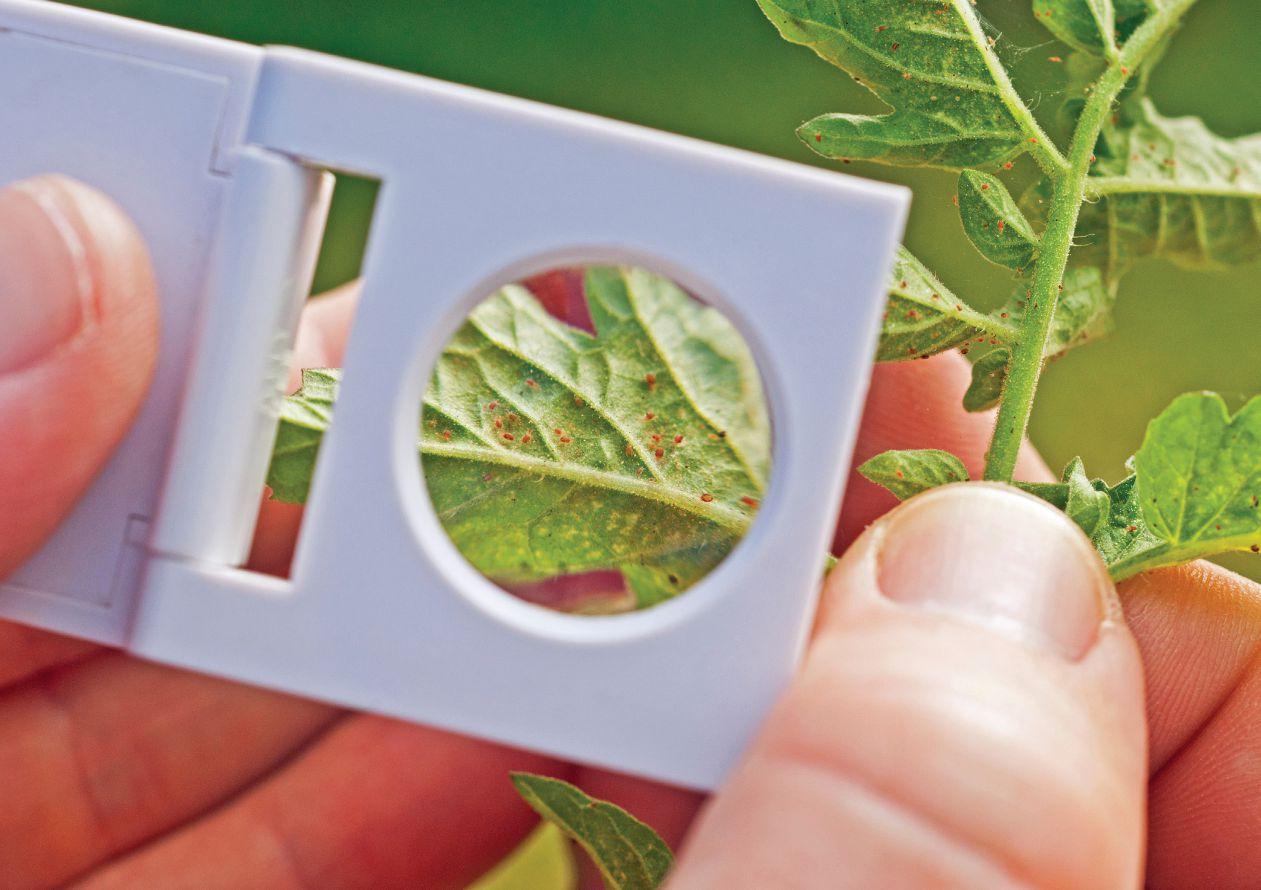
PROVEN BIOINSECTICIDE
• Broad-spectrum control of greenhouse pests including mites, aphids, thrips, and whiteflies, with no known risks of resistance.
• Excellent rotational compatibility in IPM programs and with biological control agents.

• Minimal risk of resistance due to multiple modes of action.

For more information, scan the QR code, or call, Toll-Free: 1-888-236-7378
About Lallemand Plant Care: For over 100 years, Lallemand has been an expert in yeast and bacteria manufacturing. It is now a global leader in the development, production, and marketing of microorganisms for various industries. Using sound science and know-how, Lallemand Plant Care provides effective microbial-based solutions that deliver agronomic, economic, and sustainable value to growers.




Benary is well known for its innovative seed treatments, and it continues to find new applications for this technology. One such application is to treat ornamental grasses to help with germination and seed handling. This year, Eragrostis, Corynephorus and Koeleria have been added to the collection of Be Green treated grass seed.
DANZIGER
Besties is a new series of Osteospermum that caught the attention of visitors to the Danziger, CAST2025 site. Besties (5) is a series with seven colours that all have a similar growth habit and bloom within five days of each other. The colours range from yellow to orange to amethyst. Of those colours, Dynamic Orange, that opens yellow and ages to have orange striping on the ray florets was my favourite. This can be grown on the cooler side, with one pinch in 1 L or 2.5L sized pots. This series will eventually replace the Ostico series.
There are three new colour additions to




the Darlin’ (6) dahlia series. Those include Scarlet (an orange colour), Pink Tint and my favourite Lemon Flare which has yellow petals framed with a pencil thin red edging. The Darlin’ series is best grown in 2.5L pots. With these additions there are now 16 colours in the series.
The verbena series, Vanessa Compact, is versatile and suits 1 L, 2.5L and basket production. There are two new releases for the coming season; the new Bicolour Marshmallow has a crisp white/pink bicolour bloom. The second colour is Compact Hot Red that is replacing the old red because it is earlier to bloom, larger blooms and more intense red colour.
The Capella (7) series of petunia is the workhorse in Danziger’s lineup of petunias. It can be used in 1L, 2.5L and hanging baskets. For 2026, there are two new colours: Berry Lace with a magenta centre and light-coloured perimeter and Hello Sunshine. Hello Sunshine has a pale-yellow colour with great branching and complete bloom coverage of the canopy. The subtle



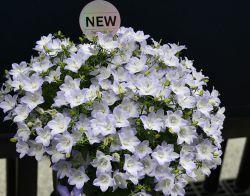
yellow shade of Hello Sunshine gives it the potential to easily blending well with other colours in mixes.
Pink Crush is a showy new addition to the Nesia series of nemesia. The attractive pink bicoloured inflorescence is prominently positioned on top of the plant. It is early to bloom and has a compact, habit that is suitable for small container growing during production but will continue growing to fill larger containers with time. Pink Crush is taller than the Denim colour.
THINKPLANTS
The ThinkPlants display was colocated with Danziger this year.
New from Kientzler Young Plants is the Ajuga Best Buddies (8) series. There are four foliage colours ranging from Lime to Espresso in intensity. This plant is hardy to Zone 4 and grows to heights of 12 cm and spreads to 30 cm. The series name suggests using this plant in container mixed combinations.




The Cariboo (9) series of campanula from Syngenta Flowers is compact and incredibly floriferous with a long bloom period. Expect this plant reach garden heights of 30 -35 cm. In the greenhouse produce in 1-2L pots. It is available in four colours ranging form white to dark blue and with bicolours. It is winter hardy to Zone 5.
Dottie is a new series of digitalis from Syngenta flowers. It is a third more compact than the Camelot series with garden heights reaching 50 cm. Secondary branching and blooming happen earlier with this series than with the Camelot series, so its floral impact and continuity of bloom is much more noticeable. The Dottie series also includes a unique peach bloom colour that isn’t found with Camelot. This series can be used in both containers and the landscape and is hardy to Zone 5.
A new addition to the ThinkPlants catalogue this year is the SunMagic (10) series of echinacea from Bull Plant Genetics. SunMagic petite Burgundy is hardy to Zone 4 and can reach garden heights of 25 cm making it a great choice for container applications as well.
The Hellebore Ice & Roses series from Heuger is also new to the ThinkPlants catalogue. It has outward faced flowers and is later to bloom to help support late winter/early spring sales. It is available in prefinished 4” in the fall from suppliers such as Aldershot Greenhouses. This series is hardy to Zone 5 and expect garden heights to reach 30-75 cm.
The Sandgem (11) series of Delosperma from Danziger has a semi-trailing habit. This low growing succulent can handle droughty conditions and frost to bloom late into the season. Two new colours, Scarlet and Purple have been added to the series and improvements have been made to the Fuchsia and Ember colours. The white colour is being dropped. Great for use in container as well as the landscape. Expect garden heights of 10 cm and a spread of 30-40 cm. Winter hardy to Zone 5.
AMERICAN TAKII
Central to the Takii stop was a large display of their new Digitals release – Hanabee (12). This series name means ‘Fireworks’ in Japanese. The genetics for Hanabee comes from the Panther digitalis that was released from Takii a few years ago. The Hanabee series is free branching, with lots of flower spikes and will bloom freely in its is first year to bloom. It should be treated like an annual as it will unlikely survive the winter.
Available in rose, pink and white; has sterile flowers so will last a long time.
The Belize (13) series of interspecific hybrid zinnia is naturally very compact and maintains a tidy habit in the garden throughout the growing season. There are a lot of new colours being evaluated for future release but this year’s Double Pink Bicolour release caught my eye. Other colour releases this year include Double Bright Rose and Double Rose Gen 2. In addition to be compact this series is also resistant to powdery mildew.
RHAPSODY
Two new colours have been added to the Trilogy (14) series of petunia; those are Blue Vein and Rose Vein.
SAHIN
This CAST display showcases plant varieties suitable for use in the home garden. Allison Zeeb of Sahin/Takii Europe put together some attractive and rustic window boxes to show off Sahin’s California poppy Thai Silk Formula Mix (15) and Cosmos sulphureus Brightness Red (16).

Proven disease control
When you need proven plant protection for greenhouse vegetables, greenhouse ornamentals and outdoor ornamentals, Envu is ready with solutions you can trust. Rhapsody® ASO is an OMRI-certified biologic fungicide labelled for fungal and bacterial diseases that uses multiple modes of action to outperform leading synthetic chemistries.
CONTACT:
Darcy Olds Key Accounts Manager darcy.olds@envu.com • 905-464-8399

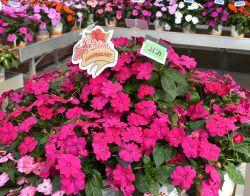
HILVERDAFLORIST


Hilverdaflorist is making improvements in its Beauties (17) series to reduce wispiness and create a creeping phlox look for the summer. The Beauties series of dianthus is very programmable; four weeks after trimming, this series will produce a new flush of bloom. This series is first-year flowering without vernalization. Five new colours have been added to the series.
The Garvinea (18) series of gerberas is known for its garden performance. It has resistance to thrips and cold tolerance. Two new colours have been added this year and were on display at CAST. These were Majestic Yellow and Sweet Chili.
JALDETY
Centradenia floribunda ‘Pink’ (19) may not be commonly grown in Canada but the specimen on display at CAST by Jaldety was impressive. This shrubby plant had a semi-trailing/cascading habit with large showy blooms and would well suit large container applications.



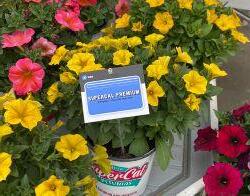
Petunia Tumbelina Compact Nicola (20) caught my eye at the Cohen display. This purple/white bicolour, semi-double petunia selection has a trailing habit that is well suited for hanging basket applications.
HISHTIL
Once again, Hishtil overwhelmed its visitors with its tremendous selection of herbs. One that stood out for me was the sage, Ovalet (21). This selection of Salvia officinalis has a sweet fragrance and attractive foliage. It is only winter hardy to Zone 6 but has great powdery mildew tolerance.
SAKATA
It’s hard to believe that is has been 20 years since SunPatiens (22) was launched. The first releases were very vigorous as it was close to the original germplasm from Indonesia. (As an aside, it was interesting to hear that Sakata pays the Indonesian government for the use of the original

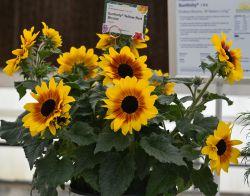


germplasm.) Since 2005, breeding has taken place to increase bloom size and control the vigour of the plant.
When at Sakata, the results of a consumer survey were revealed that talked about consumer buying habits with respect to garden centres. There is a lot of information about this survey that I don’t know (like the demographic etc.) but 82 per cent of the respondents said they buy two or more planters every year, while 43 per cent say they buy four or more every year. Additionally, 80 per cent don’t care what the container looks like as long as the plant quality is good and that they like the appearance of the plants
New colours continue to be released for the SuperCal (23) and the SuperCal Premium series. SuperCal is a 15-year-old series. Six years ago, improved versions were introduced under the marketing label of Beauty Cal in Europe and SuperCal Premium in North America. All new
Continued on page 31
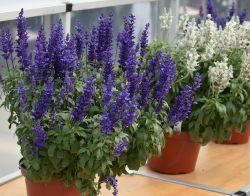

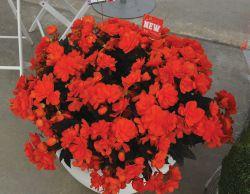

COHEN


Seasonal shifts call for strategic adjustments
Balancing growth and light in greenhouse cucumbers through the changing seasons
BY MOHYUDDIN MIRZA
Production of high-quality greenhouse cucumber requires detailed attention to seasonal light conditions. Although some growers may start using supplemental light in August, that still is supplemental to sunlight and may not meet the Daily Light Integral Light (DLI) requirement of the plants.
A DLI of between 20 to 30 moles/m2/day is considered good for higher yields and improved fruit quality. If adequate light is not available in the Fall crops the resulting fruit size could be
ABOVE
significantly reduced and grades may also be negatively affected.
I was recently looking at the data from a grower who planted crops in August. The harvest, started in the first week of October to end of November, was down by 57 per cent when compared to a spring crop. For example, for this particular grower, spring yield was 135 cucumbers/m2 starting from the third week of February to third week of July. The yield from a fall crop planted in August and harvest starting in first week of October to end of
As the seasons slowly start to change, growers of greenhouse cucumbers should consider the shifting light conditions and adjust crop management strategies accordingly.
November was 77 cucumbers/m2. A total yield of 212 cucumbers/m2 is a very good yield and the grower paid full attention to adjust to lower light conditions.
So, here are some details to be considered:
Plant focus: In August-planted crops, the focus should be to build a strong plant with large leaves, keeping in mind that this plant is gradually going into low-light conditions. There is always a risk of plant becoming more vegetative so attention should be paid to have a balanced crop. That is where grower’s experience comes in. A sharp eye is needed to determine the balance between vegetative and generative growth. If you look at Image 1, the leaves are very large and that is a vegetative signal and it is further indicated by fruit abortion in Image 2. So, growers can use different parameters to check if growth is balanced or not.
For August-planted crops, keep in mind diseases which may come due to high density and poor air movement at plant level. Besides horizontal air movement, installing those vertical


IMAGE 1

IMAGE 2
25_007006_Greenhouse_Canada_AUG_CN Mod: June 17, 2025 3:17 PM Print: 07/02/25 12:55:46 PM page 1 v7

Very large leaves are an indication of vegetative growth outpacing generative growth in this cucumber crop.
This is an example of fruit abortion in a cucumber plant the exhibited overly vegetative growth.


ORDER BY 6 PM FOR SAME DAY SHIPPING

Target Temperatures: Temperature management is very important for fall crops due to declining light levels. During the early phase of establishment, keep night temperature 21 to 22ºC and day temperature 24ºC.
• Once flowering is slowed, temperature must be reduced. Night 17 to 18ºC, and day 21 to 22ºC.
• Based on declining light, adjust 24-hour average temperature 21 to 21.5ºC in September, 20 to 20.5ºC during October and close to 20ºC in November.
• Ramping from day to night and night to day is very critical for the crop at this time. Generally, it is recommended to ramp 1ºC per hour.
• Pay attention to leaf temperature rather than just the air temperature because on clear cold nights tissue
Cucumber fruit development requires a minimum of 350 joules/cm2 per day for normal growth?
temperatures drop below air temperature and sufficient time is required for plant and fruit temperatures to reach day time set point without forming condensation. There are warning signs of condensation on leaves not on the leaf surface but just on the edges like in Image 3 This type of edge burn indicates that
IMAGE 3
The type of leaf burn pictured here is the result of condensation and indicates that adjustments in temperature and irrigation are needed to accommodate for seasonal changes.
temperature ramping from day to night is not good. If temperature is faster than 1ºC per hour and last irrigation was two hours before sunset, then the roots are still pumping water and the leaf temperature has dropped to a level where “guttation” is occurring. Adjust your temperature and irrigation practices accordingly.
Target CO2: Because of sharp decrease in light intensity during the Fall, available light should be used optimally with maximum carbon dioxide levels. Target should be around 1000 ppm. If using CO2 from boiler exhaust then be alert to the possibility of any pollution.
Adjustments in Irrigation/Feed:
The best course of action while light is decreasing is to adjust irrigation volumes and schedules. From late September onward apply first irrigation about an hour after sunrise and last watering two hours before sunset to avoid any root pressure issues. Make irrigation timing adjustments according good light conditions and cloudy situations. As light levels decrease, the Electrical Conductivity (EC) can be increased in the growing medium. As a guideline in September, the recommended EC is between 3.0 to 3.5 mS/cm; in October around 4.0; and November as high as 4.5 mS/cm
Target Leaf Number: Lead dieback is more common in fall crops due to a lower VPD due to high relative humidities. Infection from deleafing can become a serious issue. Regular scouting should be done for diseases.
Manage vapour pressure: Due to higher relative humidity the strategy should be to keep VPD between 4 and 7 grams/m3 of air. Since temperature is to be kept close to targets, manage relative humidity by venting and keeping pipe temperature minimum close to 40ºC to 45ºC.
To summarize, August-planted crops require close attention to climate and growers should make adjustments to reduced light intensities.
Dr. Mohyuddin Mirza, Ph.D., P.Ag. is an industry consultant in Alberta and can be reached at drmirzaconsultants@gmail.com
CONGRATULATIONS TO THIS YEAR’S WINNERS

Greenhouse Canada is proud to celebrate the rising stars in Canada’s greenhouse sector!
Read more about them and the work they do in the June/July 2025 issue.
Know someone worthy of Top 4 status?
Nominations open again in early 2026.
SPONSORED BY
Manufacturing

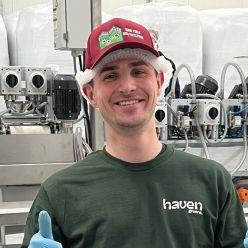

Danielle Rose
Founder and CEO of Ceragen Kitchener, ON
Digital Marketing Co-Ordinator and Webmaster, Bayview Flowers Ltd. Jordan Station, ON
Director of Cultivation, Haven Greens King City, ON
Sales Manager, Bradford Greenhouses Bradford, ON
Stewart Cameron
Dominick Dimucci
Anthony Ferragine
CULTIVATING profit
Strategic planning to boost greenhouse margins
BY MELHEM SAWAYA
The summer months are usually the time when businesses start the important process of planning for the next year. The success of this process depends on many factors Here are some good practices that will help this process stay on track:
• Take very thorough notes throughout the year — especially on areas to improve, change, or review.
• Keep actively involved in the day-to-day operations.
• Consider input from the people who are actually doing the work.
• Learn how other growers have addressed similar challenges and assess whether or not their solutions could be applied to your operation.
• Seek out reliable information sources and explore collaboration opportunities — cooperation tends to work best when it benefits everyone involved.
For some, planning for the future may require capital investment. These types of decisions fall into the following categories:
• Essential replacements and unavoidable costs like a new boiler, updated plastic, water source repairs, or replacing broken equipment.
• Efficiency upgrades that streamline workflow or reduce labour costs.
• Cost-saving systems and new installations designed to lower expenses over time.
• Quality-focused technology and tools or innovations that improve plant health and appearance.
Conducting an annual review of your greenhouse operation is a valuable exercise. Regardless of the size of your business, it’s important to look at each key sector of the operation individually.
INFRASTRUCTURE
Take a moment to consider the layout and function of the business. Think about how things would work if the receiving and shipping area are totally moved, or if there are more convenient washrooms that are closer to where the action is,

ABOVE
Combination planters, like the one pictured here at CAST 2024 from Dümmen Orange, are becoming increasingly popular among consumers and are a good way for growers to increase profit.
Whether you’re planning for the next year or five years out, breaking down each part of the business will lead to more informed, strategic decisions.
and driveways are totally changed. The point is, it is always a good exercise to think outside the box because that is where many new ideas will likely surface.
When it comes to heating, ogeneration could be an option in certain circumstances, or wood boilers or spending the money
to extend that gas line to your operation. These are major projects but if the pay back in three to five years, the expansion is justifiable.
SALES AND MARKETING
Always evaluate your customer base. Analyze the needs of the least profitable and make sure to show your appreciation to the ones that serve your business and are part of your success. Involve your customer in product selection and evaluate your product mix by calculating cost and margin profit. Eliminate the low or negative margin profit ones if there is no room for increasing selling price or reducing cost. Expect an 11 to 25 per cent increase to the cost of production cost this coming season. Make an effort to communicate these cost increases with your customers now so you can at least recover your cost increase.
LABOUR
This is likely the most expensive aspect of any operation. When it comes to saving on labour, here a few things to consider:
• Minimize it by streamlining production through detailed and timely programming,c reating and following best practices and finding ways to minimize handling of a product.
• Mechanizing routine jobs (Irrigation)
• By having the proper structure (belts, concrete aisles, concrete floors, etc.)
• Functioning and properly maintained machinery to minimize down time.
• Eliminating the bad apple that will drag good employees.
• Lead by example.
• Set goals for employees to achieve and reward those who meet them.
PRODUCTION
With the costs of inputs and production on the rise, here are some suggestions to consider for more efficient and affordable operation:
• Streamline the product you offer. This is the only way to reduce shrinkage and be able to mechanize. It will reduce inventory and result in less down time at planting and faster shipping.
• Do not jump into new varieties without trying them first at your own operation. then if all goes well and have market appeal then make it part of your production.
• Always consider photoperiod when scheduling crops: not understanding this specific crop input can lead to delayed flowering and poor crop quality at shipping time.
• Timing the crops to meet shipping target without added treatments or extra work like pinching is great way to save money and end up with a fresh product that will do well for the consumer. Aged products dry faster and will be much harder to acclimatize in the garden, in addition to the extra cost in production.
• Growing the volume of product that the greenhouse area allows and not exceeding it saves lots of extra labour and you won’t sacrifice product quality.
• When you fill larger pots that the consumer won’t use in the garden, it is especially useful to scoop the growing media from the container to leave room for the consumer



to water by hand. This gives a better chance for the product’s survival and in doing so you will be saving at least 15 per cent of the media.
• No need for saucers in the hanging baskets, especially for outdoor use. The little bit buffer is a false security for the homeowner and does nothing to improve production in the greenhouse.
• Planting healthy plugs or liners into the final container is the best insurance for the crop to stay healthy all the way till finish, without any chemical treatment. Routine fungicide treatment is costly and sometimes comes with negative side effects.
• The pot size should suit the cultivar you are planning to grow. If a variety is very vigorous it should be planted in a larger pot rather than planting it in small pot and treated to keep it short. Do not use a very compact variety in large pots, unless you put more liners or plugs per pot.
Combinations are the most popular item among all bedding plant offerings. To be profitable, here are some guidelines:
• Two cultivars in one pot are considered a combination, no need to put 5-6 different cultivars in one container, the vigorous cultivars will take over. Breeders are doing a much better job in suggesting combinations where the cultivars are combatable, but nothing takes the place of trialing them first.
• Three cultivars are optimum for a combination and the best ones are those which are from the same genus.
• A profitable combination is the one we plant and ship in six to eight weeks without any, or just one, growth regulator treatment.
• There is no place for combinations in 10” hanging baskets or pots. Combos are an upgraded item and belong in 12” and up because we charge by pot size and not what is in it. The difference in price between the 10” and 12” is $4 to $5.
• Combinations of just foliage materials are getting extremely popular and normally fast growing, which could be good idea to try.
• Planting combinations of the same growth vigour is best. Second best

is knowing the vigour of the plant material in the combo then a PGR treatment before planting the more vigorous ones to balance the growth. This will save time and money.
GENERAL OVERHEAD
This includes all indirect costs — expenses that remain constant regardless of how full your greenhouse is. These might include accountants, consultants, legal fees, or mortgage payments. These professionals are there to support you, but their value depends on how actively you engage with them. They can only help if you ask the right questions and seek the answers you need. One principle that has guided me throughout my career is the LALA theory: Look, Ask, Listen, Act.
For this approach to work, you must genuinely believe there’s always a better way to do things. The moment you assume you know it all is the moment progress starts to stall.
Melhem Sawaya is a greenhouse consultant and owner of Sawaya Gardens in Waterford, ON. He can be reached at mel@ focusgreehousemanagement.com.






intros of SuperCal Premium will bloom in photoperiods of 10.5 hours or more. The different colours in this series all have a uniform habit. The upgraded Yellow Sun (24) is more robust than the previous Yellow Sun and has less blush forming tendencies on the petals in cooler weather. This cold tolerance of SuperCal allows the expansion of the petunia market into the fall. NOTE: Growing SuperCals in July and August is different than in April and May so growers should take advantage of Sakata’s technical team to help with the process.
The Enchantment Mix is the first-time pansies and violas have been put together in a commercial mix. It is composed of ColorMax Viola Pure White and is paired with the pansies Spring Grandios Purple and Red. The resulting mix has both small and large blooms blended.

Profusion zinnias were the first powdery mildew-resistant zinnia series to hit the market, and new colours continue to be released. The new Double White (25) has ben bred for larger flowers, a great branching habit and tougher stems. More improved zinnia cultivars are in the pipeline.
Sakata is a major vegetable breeding company, so we would be remiss in not mentioning some of the exceptional vegetables that have been bred for the home gardener.
Purple Magic Broccoli has a purple head and was an AAS National winner in 2024. Likewise, the small winter squash, Thriller, won a National AAS award in 2025. This year Sakata has introduced a “purple” headed cauliflower named Amethyst (26)

KIENTZLER
On display was the new sun loving Sparkling (27) lobelia series. It is available in white, light blue and lavender colours. It exhibits excellent flowering performance and a very tidy mounding habit.
Kientzler’s Candle (28) series of Salvia farinacea has received some upgrades to the flower size of the White and Midnight colours. Our presenter spoke about the range of temperatures that this salvia species can be grown under – from extreme heat to cold conditions. This is rare within a plant species, and it opens a wide range of seasonal mixed container possibilities. It can be mixed with summer annuals and fall, frost-tolerant annuals with equal success. Some of these mixes were presented to us.

SOLUTIONS


The SunBrero (29) series of Bracteantha is new this year. It has large flowers and strong branching habit. It has medium vigour and good garden performance. For its launch, it is available in orange, pink, white, red and yellow colours. The orange, pink and yellow match well. It is daylength neutral so can bloom at any time of the year but is normally grown for the spring/summer market. It is available as a calloused cutting if rooting Bracteantha is a concern.
DAY 4
SYNGENTA FLOWERS
Day 4 was a short day with us ending our CAST2025 tour at the Syngenta stop in Gilroy.
Penny Pro (30) is the new series encompassing upgrades to the popular Penny viola series. Much like the Delta Pro series release for pansies two years ago, Penny Pro strives to address grower issues surrounding production etc. to maintain their market leading position. Examples of upgrades include compact
peduncles which reduces the need for PGRs, improved root structure, better branching, continuous bloom and a high level of uniformity across colours. This series is designed to perform well in both the spring and fall viola seasons. This series has been launched with 13 colours; for the time being, the original Penny series will continue to be available to supplement the colour range.
As the Penny Pro series adds more colours, the Penny series will eventually be discontinued.
The Sunfinity sunflower series now has a second colour available from seed. The new addition is Sunfinity Yellow Red Bicolour (31). Sunfinity is known as a season long bloomer with bloom performance lasting approximately 12 weeks. Expect garden height to reach 120 -140 cms.
Syngenta Flowers has released a new hybrid begonia series. The series iCandy (32) has five flower colours at its launch. The large, double flowers are positioned on top of dark chocolate coloured foliage. These plants will grow well in both shade and part sun conditions. As the plants grow through the summer, performance will continue to get better. Does best in pots ranging from 1 liter to basket sizes.
The Beehive series of pentas has expanded its colour range from only white to now include lilac, lipstick and pink bicolour. This is a spreading pentas from seed that starts producing 90° lateral branches early on in plant development.
Syngenta Flowers now has a black petunia in its lineup. Fun House Black Widow (33) has an intense black flower that works well with contrasting colours (i.e. yellow) in mixes.
DIRR’S ENCYCLOPEDIA OF TREES AND SHRUBS


Dirr’sEncyclopediaofTreesandShrubs is the most comprehensive visual reference on this important subject.
A combination of Dirr’s bestselling books under one cover, adding new plants, new photographs, plus all new commentary in Dirr’s signature style, it is the bible of woody plants.
From majestic evergreens to delicate vines and flowering shrubs, Dirr features thousands of plants and all the essential details for identification, planting, and care, plus full-colour photographs showing a tree’s habit in winter, distinctive bark patterns, fall color, and more.
Sunshine is a true deep yellow addition to the Sanguna (34) petunia series. Since it is daylength neutral it can be produced early in the season. This new colour is replacing the older Sanguna Yellow.
Fanatix (35) is Syngenta Flower’s new scaevola series. This is a true upgrade and redo of their scaevola assortment and features brand new genetics. Fanatix boasts better branching, flowers on top of the plant and an earlier flowering habit than the old Bombay series. Syngenta Flowers will discontinue all the Bombay colours except yellow and platinum but will move those colours under the Fanatix series name to keep ordering simple.
Sweet Duet (36) is a new seed series of snapdragon from SF. It has fragrant, double flowers available in six different colours ranging from soft pink to brilliant yellows and red. It has an excellent branching and reflowering habit. Has good heat tolerance and strong stems with garden height reaching 45 cms.
Vegetalis is Syngenta’s premium assortment of vegetables for the home and garden. The cultivars tend to be compact and suitable for small space gardening.
Some new releases for the coming season include: The Baby Jack (37) eggplant produces small deep purple fruit. The flowers are a purple colour and the foliage is an attractive grey/green. The recommended harvesting stage for the fruit is at a diameter of 5 cm.
Big Ben (38) is a traditional sweet bell pepper. It’s compact but would benefit from caging. The fruit has thick, juicy walls and can be eaten at the green or ripe red stages. It both heat and TMV tolerant.
Akoya (39) is a cocktail tomato. It has attractive purple/green foliage and dark purple fruit when they are immature. The fruit needs to ripen to a red/orange colour before it should be consumed. It is tolerant to late blight.
Rodger Tschanz is a greenhouse technician and sessional lecturer at the University of Guelph and can be reached at rtschanz@uoguelph.ca.
ED NOTE: Greenhouse Canada would like to thank the Ball Horticultural Company for welcoming our correspondent on this year’s tour of the California Spring Trials.



INSIDE VIEW
GARY JONES | greenhousewolf@gmail.com
Keeping up with Jones
‘Consumer trends’. Hmmm, we typically consider the latest and greatest new plants – bold begonias, red roses, or perhaps purple poinsettias. Ok, so maybe not the last one. Of course, breeding, developing, promoting, and delivering new cultivars is very much part of what this industry does. We have to be aware of, and at least try to stay ahead of the latest demands coming to us from our customers. Daniel Villegas, is a grower at Van Belle Nursery in B.C., and one of the three finalists in the ‘Grower Talks’/ Ball Horticultural Company 2025 ‘Young Grower Awards’. He says: “One of the primary factors that make greenhouse businesses fail is the misunderstanding of the market and its trends...Moreover, product diversification could offer opportunities to increase company profitability and reduce the risk of relying on a limited product range when customers are seeking diversity.”1
Fair enough. Any business will struggle if they don’t listen to the wants of their customers, who are being influenced through the media with images and stories of vivid new flower colours, tasty veggies, or ‘must-have’ plants. But at the next level, there are bigger external trends at work than just new cultivars. According to ‘Spherical Insights’ 2024 report, “The Canada Horticulture Market is anticipated to exceed USD 4.25 billion by 2033, growing at a [Compound Annual Growth Rate] CAGR of 9.92% from 2023 to 2033. While written prior to the changes in the U.S. administration, the report goes on to describe the factors driving these changes and subsequent industry growth: “… changing consumer preferences and urbanization lead to drive the market demand. The rising investment by Canadians in beautifying their homes and outdoor spaces surge in indoor gardening and vertical farming with the leveraging of advanced technologies like hydroponics and aquaponics are likely to enhance the market.”2
Internal trends within the (food) industry are also seeking to create change. “Though food retail has been slower than other industries to adopt disruptive technologies, proprietary research conducted by Panasonic shows that this sector is poised for change. In fact, some companies are already using technology to disrupt barriers like inefficiency in food retail, and to improve the customer experience… Among the next-gen solutions being explored are blockchain, AI, robotics and autonomous [production] – 4 of the 10 leading disruptive technologies expected to generate trillions in economic value in the decade ahead.”3
The Panasonic report highlights specifically four trends in high-tech horticulture that are changing the way our food is grown and bought:
1. The internet of plants, A.I.…
“Next-gen agriculturists are taking plants out of the soil and into water or air, combining hydroponics or aeoponics with sensors, rigorous data collection and algorithms to determine optimal conditions for superior growth. … This ‘internet of plants’ also enables growers to remotely monitor their crop health over a network…” Further, the industry is overcoming “labor shortage with the help of Harvesting Robots:” through “Leveraging AI and a camera equipped with image recognition.
2. Farms anywhere 45% of retailers are exploring indoor farming to meet the rising demand for fresh, sustainable, locally grown food. … In the U.S., urban farms are sprouting in abandoned factories, on high-rise rooftops, and within shipping containers, adopting the “farm-anywhere” approach to bring local produce to a growing population of city-dwellers.
3. Living produce Innovative grocers are taking indoor farming to a hyperlocal level, growing ripe-for-picking herbs, greens, berries and more right in their produce aisle … giving shoppers the freshest produce possible.
4. Transparency you can track Hussmann’s new startup business, Aperion, is providing Electronic Intelligent Shelf Labels to Retailers that use special NFC tags or QR codes to deliver this intel [produce freshness/quality] at the scan of a phone, driven by the desires of tech savvy Millennials and Gen Z to support responsible, environmentally friendly food sources.”
Whether you believe these ‘trends’ are real or not, there are many people who believe they are, and we ought to be trying to identify any that may affect business operations in seasons to come.
1. Daniel Villegas, June 2025, interviewed in ‘Grower Talks’, page 53.
2. https://www.sphericalinsights.com/reports/canadahorticulture-market. May 2024. Full report (I.D. #SI4340) is 200 pages, and is available from Sales@ SphericalInsights.com
3. Greg Livelli, SVP of Engineering and Marketing, Peter Webb, Business Development Analyst at Hussmann Corporation, a Panasonic company https://na.panasonic.ca/blog/4-trends-high-techhorticulture 2025.
Gary Jones sits on several greenhouse industry committees in BC and welcomes comments at greenhousewolf@gmail.com.





Rooted in Sustainability. Designed for Performance.
Black Bear® Biochar Mixes
These aesthetically pleasing, proven blends offer a climate-conscious alternative to perlite.
Black Bear® professional growing mixes replace perlite with biochar, an innovative, engineered particle that promotes aeration and drainage. Its rough particle surface sticks with other mix components and doesn’t float to the top like perlite, making it more aesthetically pleasing.


Scan to sign up for our Grower Trial Program and experience the difference.







